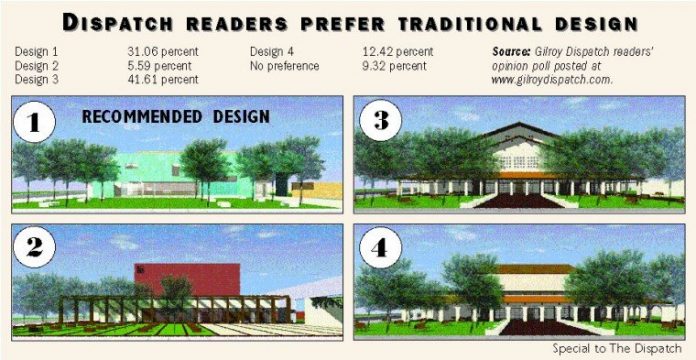GILROY
– City Council has some reservations about the ultramodern
design for Gilroy’s future arts and culture center but none
significant enough to overrule the recommendation from a special
task force.
In lieu of paying homage to years past, the vast majority of
City Council members agreed Monday night it was best to make
history by erecting an eye-popping arts facility.
GILROY – City Council has some reservations about the ultramodern design for Gilroy’s future arts and culture center but none significant enough to overrule the recommendation from a special task force.
In lieu of paying homage to years past, the vast majority of City Council members agreed Monday night it was best to make history by erecting an eye-popping arts facility. Glass, marble, colored cement and pre-patina copper will grace the landmark Monterey Street complex instead of the stucco, tile and wood variations some believe have become hackneyed.
“I think they picked the winner,” Councilman Russ Valiquette said. “I love it. It’s very pretty.”
Valiquette had concerns the structure would lend itself to vandalism given the substantial amount of glass. However, Craig Gartman was the only Council member who expressly disliked the modern rendering.
“I’m more of a traditionalist when it comes to design,” Gartman said.
Valiquette’s concern seemed easily remedied by the city’s superintendent of recreation Cheryl Bolin. Bolin said protective film could be layered over the glass, preventing graffiti from being permanently scrawled into the windows.
Matt Fischer, of San Francisco-based design form John Sergio Fisher & Associates, presented all four designs to Council members Monday night. Fischer also presented plans for the interior of the building which will serve as the premier show place for artwork and performing arts in Gilroy.
The interior design met with resounding approval from task force and Council members.
Fischer said the main hall would be capable of several configurations so there could be simultaneous performances that are isolated acoustically. He also explained that seating capacity in the hall could easily be expanded for larger venues or reduced for more intimate affairs.
The facility also will have classrooms, practice rooms, a kitchen and a bride’s room along the sides of the main hall. Outside, a grass courtyard will do double duty as a seating area for outdoor performances.
Councilman Roland Velasco raised some concerns about the facility being designed to be too versatile.
“Whenever I buy those 10-in-one tool kits, I usually find they don’t work as well,” Velasco said.
Fischer and the task force seemed to dispel the Councilman’s worries.
“We’re very well aware of do-everything facilities that don’t work,” Fischer said. “We believe we’re presenting a realistic solution, not just a dream that won’t work.”
Earlier this month, the task force selected the geometric glass, copper, cement and marble building design as its overwhelming favorite to become Gilroy’s arts and culture center in 2010. The 15-member group chose the modern-style building over three more traditional mission-style and Spanish-colonial versions.
A reader’s poll in The Dispatch did not support the task force’s decision. More than 41 percent of roughly 200 voters preferred the mission-style version resembling City Hall. The modern design garnered the second-most number of votes at 31 percent.
The $11.5 million project will become the place in Gilroy where plays, musicals, art exhibits and other cultural activities happen. Construction is slated to begin in 2008, but funding for the project is still up in the air. It will be located on the corner of Seventh and Monterey streets.
Council’s deliberation Monday night sat amid a backdrop of controversy related to Gilroy task forces. The groups have been frustrated in the past when sitting councils did not fully accept their recommendations.
The farmland preservation task force is still deliberating over a policy it recommended back in October, which was rejected by Council. The fallout nearly split up the disgruntled group, but members stayed with their charge of developing a farmland preservation policy. The revised bill goes in front of Council next month.
The next step for this task force is to develop a business plan for the arts center that will make it a mostly self-funded facility. There is talk of creating a roughly $2 million endowment for the center. The facility would use the interest from the $2 million to pay staffing and maintenance costs.
The facility also could serve as a site for weddings, seminars and other events. Rental fees could be charged with proceeds going back into the endowment.
Mayor Al Pinheiro thanked and praised the group for its efforts Monday.
“Now let’s work on the other part, the business end of this,” Pinheiro said.












